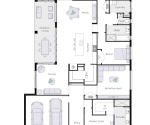One Thing I’d NEVER Skip in an Energy-Efficient Home…
When it comes to building a home that performs well year-round, I could talk all day about insulation, double glazing, and clever orientation. But if I had to choose just one thing I’d never skip in an energy-efficient build?
Thermal mass zones.
(Yes, I’m looking at you, concrete slab!)
What is thermal mass, and why does it matter?
Thermal mass refers to materials that can absorb, store, and release heat. Think concrete floors, brick walls, or even tiles in the right spot. When you design with thermal mass in mind – and pair it with good orientation – you can drastically reduce the need for artificial heating and cooling.
In my own build, the north-facing living areas are designed to soak up the winter sun during the day. That concrete slab floor? It acts like a big rechargeable battery for warmth, gently releasing heat into the space well into the evening.
Come summer, with the right eaves and cross ventilation, that same slab stays cool and helps regulate the temperature naturally. It’s a win-win.
What happens if you don’t plan for it?
It’s not just about having a concrete slab – it’s about where that slab is located. A poorly placed thermal mass (like in a south-facing room that gets no sun) can actually work against you, making the space colder or failing to provide any benefit at all.
You don’t need to go overboard, but you do need to be intentional.
My top tips for planning thermal mass zones:
- Orient key living areas to the north (in the southern hemisphere) to maximise solar gain in winter
- Use exposed concrete floors in those zones, rather than covering them with timber or carpet
- Incorporate shading and eaves to block out summer sun and avoid overheating
- Pair with good insulation and airtightness for best results
It’s a detail that can feel “in the weeds” when you’re deep in the build process – but I promise it’s one of the smartest choices you’ll make. Thermal mass is passive, low-maintenance, and can save you serious money and energy over the life of the home.
If you’re planning a build and want to get the most out of your design, don’t forget to give your slab some love.










